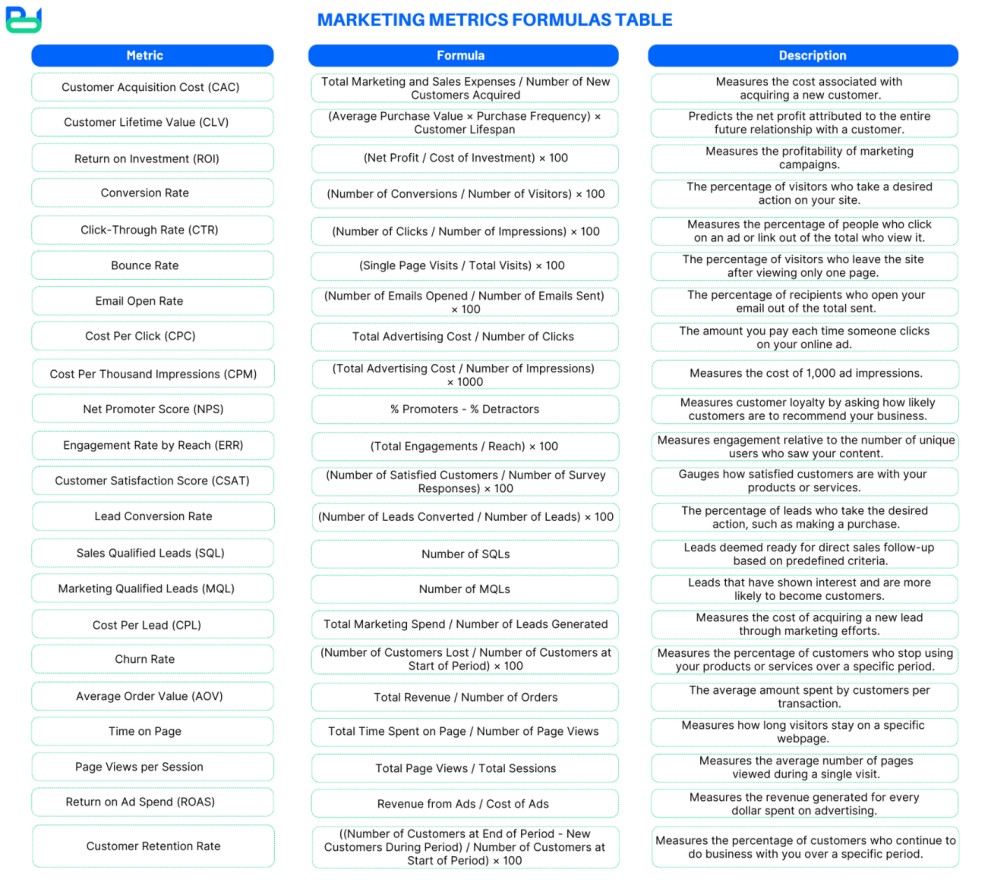When it comes to evolving digital marketing strategies, it is essential to be aware of new trends and indicators. The present and future marketing trends for 2024 must be clear to businesses on the various metrics that will determine success and high ROI. Without further ado, here are the top marketing metrics to track in 2024 that will definitely assist in the optimization of the current campaigns as well as the achievement of the overall marketing objectives.
1) Understanding Marketing Metrics
The Importance of Marketing Metrics
Marketing metrics are an integral tool that enables you to measure the effectiveness of your campaigns to help make better decisions. They allow you to define objectives as well as track their achievement, define shortcomings, and, thus, enhance your promotional approaches.
How to Choose the Right Metrics
Choosing appropriate metrics is contingent upon the nature of business objectives, customers, and used marketing platforms. Thus, it is imperative to concentrate not only on measures that correspond to our goals but also on measures that can offer a genuine understanding of the situation.
2) Customer Acquisition Cost (CAC)
What is CAC?
Customer acquisition cost is one of the customer metrics that defines the cost of making a new customer. These are the costs incurred in marketing, advertising, or any other effort that the company uses to sell its products.
Why CAC Matters in 2024
Monitoring of CAC assists the companies in knowing how efficient the company’s marketing plan is and analyzing which marketing avenues would be more cost-effective to invest in. Reducing CAC can have a profound effect on revenue-enhancing profitability.
How to Calculate CAC
CAC = (Total Marketing and Sales Expenses) / (New Customers Generated)
3) Customer Lifetime Value (CLV)
Defining CLV
Customer Lifetime Value is the estimate of the total net monetary value a customer incurs across the entire duration of the business relationship.
The Concept of CLV in the year 2024
CLV also assists in managing relations rather than using short-term strategies to maximize revenues. Higher CLV suggests the presence of highly loyal customers capable of generating constant revenue.
Strategies to Increase CLV
- Enhancing customer experience
- Implementing loyalty programs
- Offering personalized marketing
4) Return on Investment (ROI)
Understanding ROI
ROI measures the profitability of your marketing efforts in any campaign that you are undertaking. Marketing ROI is defined as the total net profit derived from a campaign in a particular business divided by its cost.
Why ROI is Critical
ROI is invaluable when you want to measure the effectiveness of the marketing strategies that you are implementing. High ROI will show your campaigns are earning more from marketing, meaning you are using the right marketing techniques.
Improving ROI in 2024
- Optimize ad targeting
- Reduce unnecessary expenses
- Focus on high-converting channels

5) Conversion Rate
What is the Conversion Rate?
Conversion Rate is the proportion of visitors who perform a specific activity or accomplish a particular goal, whatever that may be.
Importance of Conversion Rate in 2024
A higher conversion rate brings reassurance about the effectiveness of marketing strategies because visitors are convinced to become customers.
Tips to Boost Conversion Rates
- A/B testing landing pages
- Improving website UX/UI
- Well-written, persuasive, and distinctive calls to action (CTAs)
6) Click-Through Rate (CTR)
Defining CTR
The click-through rate is calculated as the number of people who clicked on the ad/link divided by the total number of people who saw the ad/link.
Significance of CTR
High CTR means that your ads or any content were appealing and successful in capturing the interest of your target market.
Enhancing CTR
- Crafting compelling headlines
- Using engaging visuals
- Targeting the right audience
7) Bounce Rate
What is Bounce Rate?
The bounce rate is the percentage of visitors who leave your site after only viewing one page.
Why Bounce Rate Matters
Bounce rate is the percentage of your visitors who enter the site and then leave without clicking any other page; therefore, a high bounce rate may suggest that the content needs to be updated or the site design needs to be revamped.
Reducing Bounce Rate
- Improving page load times
- Enhancing website design
- Providing valuable content
8) Social Media Engagement
Understanding Social Media Engagement
Engagement here refers to the number of likes, comments, shares, and any other form of interaction that occurs regarding the content you post on social media platforms.
The Role of Social Media Engagement in 2024
High engagement levels are one way of increasing the popularity of the brand and encouraging customer loyalty.
Strategies to Increase Engagement
- Posting high-quality content
- Engaging with followers
- Running social media contests
9) Email Open Rate
What is the Email Open Rate?
The email open rate is calculated as the number of opens divided by the total number of emails sent out.
Importance of Email Open Rate
It is an indication that your subject lines are interesting and your audience receives and considers your emails as valuable.
Improving Email Open Rates
- Crafting attention-grabbing subject lines
- Personalizing email content
- Segmenting your email list
10) Cost Per Click (CPC)
Defining CPC
The cost per click is the amount you pay every time someone clicks on your online ad.
Why CPC Matters
CPC is useful because it helps you control the amount of money you spend on ads and makes it easier to find the most cost-effective clicks.
Reducing CPC
- Targeting the right keywords
- Improving ad quality
- Using negative keywords
11) Cost Per Thousand Impressions (CPM)
What is CPM?
CPM calculates the cost per thousand impressions of an advertisement or promotional media.
The Significance of CPM
CPM is appropriate for brand awareness campaigns where impressions matter more than click-through rates or conversion rates.
Optimizing CPM
- Targeting specific demographics
- Using engaging ad creatives
- Analyzing impression data
12) Net Promoter Score (NPS)
Defining NPS
Net Promoter Score is a customer loyalty index that can be obtained through questions like ‘How likely are you to recommend our business?
The Role of NPS in 2024
Customers with a high NPS are satisfied with the products offered by a particular firm and are thus likely to be brand advocates, fostering the business’s organic growth.
Improving NPS
- Enhancing customer service
- Addressing feedback promptly
- Delivering exceptional experiences
13) Engagement Rate by Reach (ERR)
What is ERR?
ERR calculates the proportion of engagement per reach, namely the number of individual accounts that viewed the content.
Why ERR Matters
Through ERR, you further understand how good your creation is in terms of engaging with your niche.
Boosting ERR
- Creating shareable content
- Engaging with your audience
- Posting at optimal times
14) Customer Satisfaction Score (CSAT)
Defining CSAT
Customer Satisfaction Score helps to know the customer satisfaction level regarding your products or services.
The Importance of CSAT
Reading CSAT scores implies that your customers are satisfied, which in turn means they are more likely to be loyal and would recommend your product.
Increasing CSAT
- Providing excellent customer support
- Gathering and acting on feedback
- Ensuring high-quality products/services
15. Website Traffic Sources
Understanding Traffic Sources
Traffic sources show from where the visitors of your site have come, whether they are through a search engine, social media, links directly or others.
Why Tracking Traffic Sources is Important
This means it provides you an insight into which of your traffic sources are most effective in bringing visitors to your site.
Optimizing Traffic Sources
- Investing in SEO
- Running targeted ad campaigns
- Leveraging social media
16. Organic Search Traffic
What is Organic Search Traffic?
Organic search traffic is any visitor that comes to a website through a search engine by typing a keyword into the engine’s search bar, and the engine provides a list of searches that the visitor specifically looks for.
The Value of Organic Search Traffic
High organic traffic is essential to show that your SEO strategy is working and that the content you are providing people with is useful.
Increasing Organic Search Traffic
- Creating high-quality content
- Optimizing for relevant keywords
- Building backlinks
17. Paid Search Traffic
Defining Paid Search Traffic
Paid referral traffic appears if people click on your Ads that are placed in search engine results.
Importance of Paid Search Traffic
It is a perfect way to bring targeted traffic to your site within a short period without overshadowing the organic business.
Optimizing Paid Search Campaigns
- Using precise keyword targeting
- Crafting compelling ad copy
- Monitoring and adjusting bids
18. Referral Traffic
What is Referral Traffic?
Referral Traffic is usually from visitors who have been redirected to your site by links from other websites.
The Role of Referral Traffic
Referral traffic can indicate the effectiveness of your link-building and partnership strategies.
Increasing Referral Traffic
- Building partnerships with relevant websites
- Guest blogging
- Sharing content on social media
19. Direct Traffic
Understanding Direct Traffic
Direct traffic can be defined as those visitors who entered your site’s URL on their browser manually, or visitors who use bookmarked sites.
Why Direct Traffic is Important
High direct traffic implies that the brand name is well recognized in the market and its product loyalty.
Boosting Direct Traffic
- Promoting your brand offline
- Encouraging repeat visits
- Using memorable URLs
20. Mobile Traffic
What is Mobile Traffic?
Mobile Traffic is the total number of visitors coming to the site using browsers on mobile devices.
The Significance of Mobile Traffic
However, as mobile traffic continues to grow, it is vital to address it to ensure the smooth operation of a website.
Enhancing Mobile Traffic
- Implementing responsive design
- Improving mobile page load times
- Simplifying mobile navigation
21. Lead Conversion Rate
21. Lead Conversion Rate
Defining Lead Conversion Rate
Lead Conversion Rate is the ratio of those who followed the desired call-to-action: those who bought a product subscribed to a newsletter, and so on.
Why Lead Conversion Rate Matters
Visitors who have clicked your link have been shown to be interested, and this means that the strategies you are using to nurture the leads are good.
Improving Lead Conversion Rates
- Personalizing follow-up communications
- Offering incentives
- Simplifying the conversion process
22. Sales Qualified Leads (SQL)
22. Sales Qualified Leads (SQL)
What are SQLs?
The Sales Qualified Leads are the leads that are considered ready for a direct sales follow-up, taking into consideration a set of criteria.
The Role of SQLs in 2024
They assist in marketing and sales coordination since they monitor the SQLs to determine whether or not leads are ready for a handoff.
Increasing SQLs
- Implementing lead scoring
- Aligning marketing and sales teams
- Using targeted marketing campaigns
23. Marketing Qualified Leads (MQL)
Defining MQLs
Marketing Qualified Leads are prospects who have expressed interest in the product or service offered by the company and, therefore, are potentially good customers.
Why MQLs are Important
It is helpful to determine MQLs as it focuses the work of the enterprise on the leads with the highest conversion probability.
Generating More MQLs
- Offering valuable content
- Running targeted campaigns
- Engaging with prospects
24. Cost Per Lead (CPL)
What is CPL?
Cost Per Lead is the cost of marketing that particular product, service, or event divided by the number of leads received.
The Importance of CPL
Monitoring CPL enables one to manage the amount of money being spent on marketing and attract more affordable leads.
Reducing CPL
- Improving ad targeting
- Using cost-effective channels
- Refining marketing strategies
25. Customer Retention Rate
Defining Customer Retention Rate
Customer Retention Rate is calculated as a percentage of customers who remain loyal and continue to engage you over a given period.
Why Customer Retention is Crucial
Customer retention rates show that the organization is delivering quality services to their clients, and therefore, they are loyal to the services being offered to them.
Increasing Retention Rates
- Providing excellent customer service
- Implementing loyalty programs
- Engaging with customers
26. Churn Rate
What is the Churn Rate?
Churn Rate measures the percentage of customers who stop using your products or services over a specific period.
Significance of Churn Rate
This implies that a high churn rate may be an indication of customer dissatisfaction or low-quality products.
Reducing Churn Rate
- Enhancing product features
- Providing exceptional support
- Analyzing and addressing churn reasons
27. Average Order Value (AOV)
Defining AOV
Average Order Value refers to the extent of the value consumers spend on a single purchase.
The Role of AOV in 2024
Increasing AOV can boost revenue without acquiring new customers.
Strategies to Increase AOV
- Upselling and cross-selling
- Offering bundled products
- Implementing loyalty programs
28. Time on Page
What is Time on Page?
Time on Page is a metric of how long visitors spend their time on any specific page of the website.
Why Time on Page Matters
More time spent on the page is beneficial since it shows the target audience is interested in the content and enjoys the interface.
Increasing Time on Page
- Creating valuable content
- Using multimedia elements
- Improving readability
29. Page Views per Session
Understanding Page Views per Session
Page Views per Session reflects the average number of pages looked at by one visitor during the time they spend at a site.
Significance of Page Views per Session
This shows that the visitors of your website are finding it useful and engaging since they view many pages during one session.
Boosting Page Views per Session
- Improving internal linking
- Creating engaging content
- Enhancing site navigation
30. Return on Ad Spend (ROAS)
What is ROAS?
Return On Ad Spend focuses on the total amount of revenue that one can earn for every dollar spent on advertising.
The Importance of ROAS
A high ROAS means that the ads you place for your business are worthy and they help you make a profit.
Improving ROAS
- Optimizing ad targeting
- Using compelling creatives
- Continuously testing and refining ads
Conclusion
Underlying metrics used in the year 2024, when adjusted to new targets, will enable you to fine-tune campaigns to yield even greater levels of the respective ROI and surpass competitors. In order to stay afloat and relevant in the global digital market, focusing on the named values will assist in performing data-driven actions. Thus, regardless of whether you are a digital marketing agency or just a firm that is adapting to a strategy where it needs to incorporate the right metrics for success, these metrics will help you achieve your goals.


